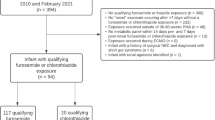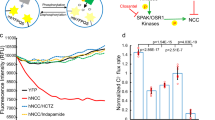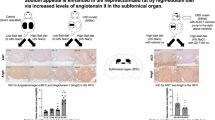Abstract
Background:
Nephrocalcinosis (NC) is an important clinical problem seen in critically ill preterm neonates treated with loop diuretics. No reliable animal models are available to study the pathogenesis of NC in preterm infants. The purpose of this study was to develop a reproducible and clinically relevant animal model of NC for these patients and to explore the impact of extracellular fluid (ECF) volume contraction induced by sodium and chloride depletion in this process.
Methods:
Three-week-old weanling Sprague-Dawley rats were fed diets deficient in either chloride or sodium or both. A subgroup of rats from each dietary group was injected daily with furosemide (40 mg/kg i.p.).
Results:
Rats fed a control diet, with or without furosemide, or a chloride-depleted diet alone, did not develop NC. By contrast, 50% of the rats injected with furosemide and fed the chloride-depleted diet developed NC. Moreover, 94% of the rats fed the combined sodium- and chloride-depleted diet developed NC, independently of furosemide use. NC was associated with the development of severe ECF volume contraction; hypochloremic, hypokalemic, metabolic alkalosis; increased phosphaturia; and growth retardation.
Conclusion:
Severe ECF volume contraction induced by chronic sodium and chloride depletion appears to play an important role in the pathogenesis of NC.
Similar content being viewed by others
Log in or create a free account to read this content
Gain free access to this article, as well as selected content from this journal and more on nature.com
or
References
Pasternack A, Perheentupa J, Launiala K, Hallman N . Kidney biopsy findings in familial chloride diarrhoea. Acta Endocrinol 1967;55:1–9.
Hufnagle KG, Khan SN, Penn D, Cacciarelli A, Williams P . Renal calcifications: a complication of long-term furosemide therapy in preterm infants. Pediatrics 1982;70:360–3.
Cranefield DJ, Odd DE, Harding JE, Teele RL . High incidence of nephrocalcinosis in extremely preterm infants treated with dexamethasone. Pediatr Radiol 2004;34:138–42.
Hein G, Richter D, Manz F, Weitzel D, Kalhoff H . Development of nephrocalcinosis in very low birth weight infants. Pediatr Nephrol 2004;19:616–20.
Hoppe B, Duran I, Martin A, et al. Nephrocalcinosis in preterm infants: a single center experience. Pediatr Nephrol 2002;17:264–8.
Ketkeaw K, Thaithumyanon P, Punnahitananda S . Nephrocalcinosis in very low birth weight infants: a single center experience. J Med Assoc Thai 2004;87 :Suppl 2:S72–7.
Schell-Feith EA, Kist-van Holthe JE, Conneman N, et al. Etiology of nephrocalcinosis in preterm neonates: association of nutritional intake and urinary parameters. Kidney Int 2000;58:2102–10.
Holmberg C . Congenital chloride diarrhoea. Clin Gastroenterol 1986;15:583–602.
Downing GJ, Egelhoff JC, Daily DK, Thomas MK, Alon U . Kidney function in very low birth weight infants with furosemide-related renal calcifications at ages 1 to 2 years. J Pediatr 1992;120(4 Pt 1):599–604.
Ezzedeen F, Adelman RD, Ahlfors CE . Renal calcification in preterm infants: pathophysiology and long-term sequelae. J Pediatr 1988;113:532–9.
Holmberg C, Perheentupa J, Pasternack A . The renal lesion in congenital chloride diarrhea. J Pediatr 1977;91:738–43.
Bérard E, Dageville C, Bekri S, Boutté P, Coussement A, Mariani R . Nephrocalcinosis and prematurity: importance of urate and oxalate excretion. Nephron 1995;69:237–41.
Woolfield N, Haslam R, Le Quesne G, Chambers HM, Hogg R, Jureidini K . Ultrasound diagnosis of nephrocalcinosis in preterm infants. Arch Dis Child 1988;63:86–8.
Pope JC 4th, Trusler LA, Klein AM, Walsh WF, Yared A, Brock JW, 3rd. The natural history of nephrocalcinosis in premature infants treated with loop diuretics. J Urol 1996;156:709–12.
Wedenoja S, Ormälä T, Berg UB, et al. The impact of sodium chloride and volume depletion in the chronic kidney disease of congenital chloride diarrhea. Kidney Int 2008;74:1085–93.
Campfield T, Braden G, Flynn-Valone P, Powell S . Effect of diuretics on urinary oxalate, calcium, and sodium excretion in very low birth weight infants. Pediatrics 1997;99:814–8.
Alon US, Kaplan RA, Gratny LL, Nichols MA . Histological long-term outcome of furosemide-induced nephrocalcinosis in the young rat. Pediatr Nephrol 1996;10:191–4.
Levine DZ, Roy D, Tolnai G, Nash L, Shah BG . Chloride depletion and nephrocalcinosis. Am J Physiol 1974;227:878–83.
Holliday MA, Bright NH, Schulz D, Oliver J . The renal lesions of electrolyte imbalance. III. The effect of acute chloride depletion and alkalosis on the renal cortex. J Exp Med 1961;113:971–80.
Mackay EM, Oliver J . Renal damage following the ingestion of a diet containing an excess of inorganic phosphate. J Exp Med 1935;61:319–34.
Ray PE, Lyon RC, Ruley EJ, Holliday MA . Sodium or chloride deficiency lowers muscle intracellular pH in growing rats. Pediatr Nephrol 1996;10:33–7.
Ray PE, Castrén E, Ruley EJ, Saavedra JM . Different effects of sodium or chloride depletion on angiotensin II receptors in rats. Am J Physiol 1990;258(4 Pt 2):R1008–15.
Lane PH, Tyler LD, Schmitz PG . Chronic administration of furosemide augments renal weight and glomerular capillary pressure in normal rats. Am J Physiol 1998;275(2 Pt 2):F230–4.
Lane PH . Furosemide treatment, angiotensin II, and renal growth and development in the rat. Pediatr Res 1995;37:747–54.
Heinly MM, Wassner SJ . The effect of isolated chloride depletion on growth and protein turnover in young rats. Pediatr Nephrol 1994;8:555–60.
Orent-Keiles E, Robinson A, McCollum EV . The effects of sodium deprivation on the animals organism. Am J Physiol 1937;119:651–61.
Gratny LL, Ringer K, Hall RT, Alon US . Salt supplementation, growth, and nephrocalcinosis in the furosemide-treated weanling rat. Biol Neonate 1997;71:37–45.
Hitchman AJ, Hasany SA, Hitchman A, Harrison JE, Tam C . Phosphate-induced renal calcification in the rat. Can J Physiol Pharmacol 1979;57:92–7.
McNabb WR, Noormohamed FH, Brooks BA, Lant AF . Renal actions of piretanide and three other “loop” diuretics. Clin Pharmacol Ther 1984;35:328–37.
Haas JA, Larson MV, Marchand GR, Lang FC, Greger RF, Knox FG . Phosphaturic effect of furosemide: role of PTH and carbonic anhydrase. Am J Physiol 1977;232:F105–10.
Pattaragarn A, Fox J, Alon US . Effect of the calcimimetic NPS R-467 on furosemide-induced nephrocalcinosis in the young rat. Kidney Int 2004;65:1684–9.
Soeterboek SJ, Ritskes-Hoitinga J, Lemmens AG, Beynen AC . Phosphorus-induced nephrocalcinosis in female rats: a study on regression and clinical abnormalities. Lab Anim 1991;25:258–62.
Heaton FW, Anderson CK . The mechanism of renal calcification induced by magnesium deficiency in the rat. Clin Sci 1965;28:99–106.
Van Camp I, Ritskes-Hoitinga J, Lemmens AG, Beynen AC . Diet-induced nephrocalcinosis and urinary excretion of albumin in female rats. Lab Anim 1990;24:137–41.
Hoek AC, Lemmens AG, Mullink JW, Beynen AC . Influence of dietary calcium:phosphorus ratio on mineral excretion and nephrocalcinosis in female rats. J Nutr 1988;118:1210–6.
Acknowledgements
The authors acknowledge Pedro Jose, director of Pediatric Nephrology Research and professor in the Departments of Pediatrics and Physiology & Biophysics at the University of Maryland School of Medicine, for his critical advice, expertise, and laboratory support in the performance of this project.
Author information
Authors and Affiliations
Corresponding author
Rights and permissions
About this article
Cite this article
Tuchman, S., Asico, L., Escano, C. et al. Development of an animal model of nephrocalcinosis via selective dietary sodium and chloride depletion. Pediatr Res 73, 194–200 (2013). https://doi.org/10.1038/pr.2012.172
Received:
Accepted:
Published:
Issue date:
DOI: https://doi.org/10.1038/pr.2012.172
This article is cited by
-
What is nephrocalcinosis?
Kidney International (2015)



